The municipality of Santa María de Guía offers several possibilities for leisure and tourist visits for those interested in seeing architecture and natural areas.
A walk through the streets of Santa María de Guía gives visitors the chance to appreciate the beauty of the buildings, particularly after the houses in the urban centre underwent a recent process of painting and beautification. Visitors can lose themselves in a world full of colour and cheerfulness that will take them back to the former splendour of the municipality.

The historic centre was declared a National Historic–Artistic Monument in 1982. Highlights of the buildings include the Parish Church, with its neoclassical façade flanked by two lateral towers. Inside there are some major works of art, including altarpieces and statuary by the sculptor José Luján Pérez, native of the municipality. Another place to visit inside the church is the Camarín de la Virgen (side-chapel), open on Wednesdays and Saturdays from 10:00 am to 14:00 pm. This is the resting place of the patron saint, where several pieces of work in precious metals are on display, in particular the silver baldachin canopy framing the statue of La Virgen de Guía. There are also items of textile such as the robes for the statue, banners, mantles, Dalmatian chasubles, cloaks and vestments used by the clergy in former times.
La Casa de Los Quintana, located in la Plaza Mayor de Guía and dating from the seventeenth century, is another example of the typical architecture of the municipality. It has a particularly attractive balcony in the Canary Islands–Mudejar style, as well as a coat of arms with the surnames Guanarteme and Quintana.
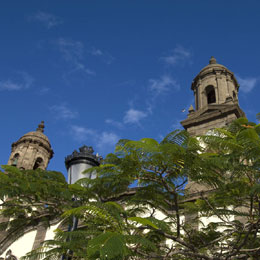
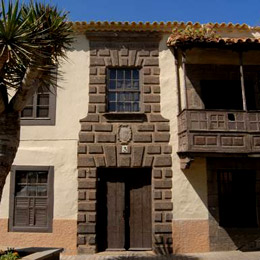
La Casa de Néstor Álamo in la calle San José is another place worth visiting. This is a house built in the seventeenth century and recently restored by the Cabildo Insular and the Guía Town Hall to be used as a museum dedicated to this author.
The Chapel of San Roque also forms part of the Historic Heritage. It is located in the square of the same name, in the upper part of the city. It is a relatively modern building in the neoclassical style, built with local limestone and quarry stone. The Chapel of San Sebastián is a typical Canary Islands chapel of the sixteenth century and recently restored in the original style.
For visitors who wish to see the natural environment of the municipality, one of the highlights is the Special Natural Reserve of El Brezal, whose flora is made up primarily of laurels, holly and different varieties of heath.
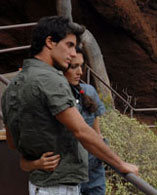
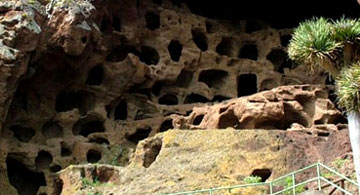
Another of the more characteristic places of Guía is El Cenobio de Valerón, an archaeological site that was declared a Resource of Cultural Interest in 1978. El Cenobio was a large fortress granary where the pre-Hispanic population stored its surplus in hollows dug into the rock. El Tagoror del Gallego is another of the island’s archaeological sites, and consists of a semicircular area in which there are three thrones made from stone extracted from the mountain. The thrones are surrounded by what may have been a form of seating, and it is thought that the area may have been a "Court House".
Santa María de Guía is a municipality with a primarily rocky coastline. Nonetheless, it has three beaches which are mainly used by the residents of the area.
La Playa de San Felipe is in the far western part of the coast of Lairaga. It can be reached by taking a well-defined track from El Cruce de El Pagador.
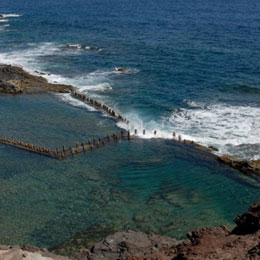

One of the main attractions of the beach, apart from the fact that there is little tourism, is the chance to do some surfing, as there are big waves in this area. There are also steep cliffs in this part of the island, which means that parapenting is often done here.
Many of the best restaurants and bars of the municipality are located in this area. They offer dishes based on products taken fresh from the sea every day.
La Playa de Roque Prieto is located in the area of La Atalaya, two kilometres from the town centre. One of its attractions is the natural pool, with its ideal conditions for bathing. Finally, la Playa de Caleta Arriba, on the border between Guía y Gáldar, is another peaceful coastal area which is hardly ever disturbed by visitors.
Guía is one of the most craft-oriented municipalities of Gran Canaria. Visitors can choose between several craft workshops or the municipal market, in la Plaza Grande and la Plaza de Luján Pérez, which opens its doors on Tuesdays and Sundays from 8.30 am to 13.00 pm. For those who wish to buy local produce, Guía is known above all for its cheese making.
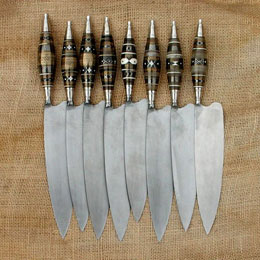

For those interested in buying craft products, Santa María de Guía is one of the municipalities where the making of the Canary Islands knife is most deeply rooted. The Canary Islands knife is an item that was carried by the farmers of the island. The handle is made with metal and horn insets in geometrical shapes. The blade is distinguished by its great size, measuring from 15 to 20 centimetres.
Items of woodcarving and wooden furniture are some of the other attractions of Guía. Craft workshops in the town centre offer examples of these, including miniature Canary Islands balconies, chests and Canary Islands earthenware water pitchers. Basketry and cane work are also very popular in Guía and are some of the more usual products on sale in the craft workshops.
El Queso de Flor de Guía (“flower cheese”) is the gastronomic product par excellence in Santa María de Guía. The process for making this cheese is based on curdling the cow and goat milk using the head of the flower of the blue thistle. The authenticity of the cheese also lies in the ageing process, as the cheese is placed on racks in caves with low humidity, which helps to give it a unique aroma and taste.

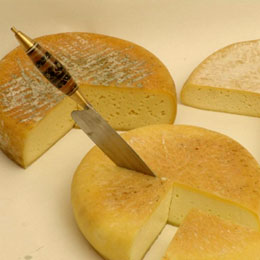
Cheese is the basic ingredient in some of the dishes that can be tasted not only in Guía but also in the rest of the island, such as cheese mojo (sauce) and fresh cheese fritters.
And while the fields of Guía are given over to livestock production, the historic centre of the town has its best representation of the local gastronomy in the confectionary. The selection is varied and includes lengüillas (“little tongues”), crunchy, crumbly biscuits that are so named for their shape, as well as biscuits and pastries with aniseed, raisins, cinnamon or almonds.
The coastal location of Guía also means that the restaurants offer the best selection of fish in the area, including baby octopus, mussels, sea bass and parrot fish.
Santa María de Guía: Download Tourist Brochure | Map | Podcast
Accommodation: Santa María de Guía
Macaronesia Tours offers guided tours to Santa Mª de Guía, with a blend of sweets, flower cheese and crafts.